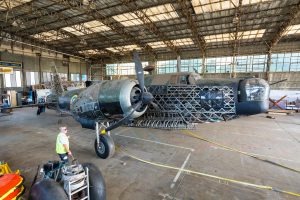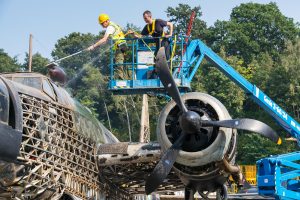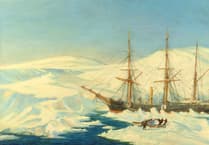The only intact Wellington bomber that saw action in the Second World War has been moved from its hangar at Brooklands Museum as part of an £8 million project that will uncover the original finishing straight of the famous racetrack.
The Vickers 290 Wellington 1A N2980, which was built by Vickers at Brooklands in 1939, was moved from the Bellman hangar, its home for the past 31 years, in a delicate operation last week. It is now in a temporary pavilion.
The hangar, which was built in 1940, is to be dismantled next month, restored and relocated in a new position at the museum. The Wellington will be moved back into the restored hangar, which will tell the story of aircraft production on the site over about 80 years.
Under the hangar, and consequently hidden for more than 70 years, is the missing section of the original finishing straight which will be rejoined with the banking section of the racetrack and create a continuous loop with the bottom of Test Hill.
The newly restored finishing straight is due to open on 17 June next year, exactly 110 years to the day that the Brooklands Race Track opened. Visitors will be able to see the original views from north to south for the first time since the track was closed to the public in 1939.
Paul Stewart, a museum spokesman, said a team of about 30 staff and volunteers took six hours to move the Wellington a few hundred years from the hangar to the pavilion.
“We had to take the wings off because it was safer structurally and also because we could not be certain it would fit through hangar doors.

“The move involved everything from winching it up so the back wheel could be put on a skate to carefully pushing it along. It stopped halfway along its journey to have a wash,” Paul said.
There were a few hundred visitors at the museum on the day, many of whom had come specifically to see the Wellington being moved and to see it virtually intact outdoors.
“It completely stopped everyone in their tracks – we have some contractors working on the £8.1 million Heritage Lottery Funded Brooklands Aircraft Factory and Race Track Revival Project and they were fascinated by the sight. It was quite emotional to see the aircraft come outside and present itself so majestically,” Paul said.
N2980 was first issued to 149 Squadron at RAF Mildenhall and allocated the squadron code letter R for Robert. It took part in the infamous Heligoland Bight raid on the 18 December, 1939, during which more than half the 22 Wellingtons involved were shot down by German fighters. N2980 later served with 37 Squadron at RAF Feltwell, taking part in 14 operations including day and night raids.
Its war ended on 31 December 1940 when it developed engine trouble during a training flight and ditched into Loch Ness. All the crew escaped, but the rear gunner was killed when his parachute failed to deploy.

The wreckage was found in 1976 by a team of American Loch Ness monster hunters and salvaged in September 1985 by the Loch Ness Wellington Association assisted by the National Heritage Memorial Fund. The bomber was remarkably well preserved. The taillights still worked when connected to a modern battery and many of the crew’s personal effects remained in the fuselage.
It was taken back to Brooklands where it was reassembled, restored and put on display in the Bellman hangar.




